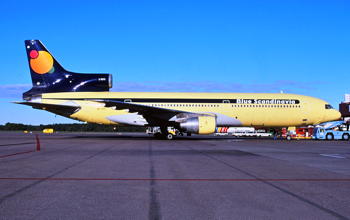
Lockheed 1011-385 Tristar Fleet:
- Antigua and Barbuda (V2)
- Bangladesh (S2)
- Canada (C)
- Chile (CC)
- Gambia (C5)
- Germany (D)
- Hong Kong (VR)
- Iceland (TF)
- Ireland (EI)
- Japan (JA)
- Jordan (JY)
- Liberia (EL)
- Peru (OB)
- Portugal (CS)
- Saudi Arabia (HZ)
- Sri Lanka (4R)
- Sweden (SE)
- Thailand (HS)
- Trinidad & Tobago (9Y)
- Turkey (TC)
- United Arab Emirates (A40)
- United Kingdom (G)
- United States of America (N)
Background Information.
The Lockheed 1011 Tristar is an American medium-to-long-range, wide-body trijet, It was the third wide-body airliner to enter commercial operations, after the Boeing 747 and the McDonnell Douglas DC-10. The Tristar has seating capacity of up to 400 passengers and a range of over 4,000 nautical miles (7,410 km). It was powered by three Rolls-Royce RB211 engines. The aircraft has an autoland capability, an automated descent control system, and available lower deck galley and lounge facilities.
The TriStar was produced in two fuselage lengths. The original L-1011-1 first flew in November 1970 and entered service with Eastern Air Lines in 1972. The shortened, longer range L-1011-500 first flew in 1978 and entered service with British Airways a year later. The original-length TriStar was also produced as the high gross weight L-1011-100, up-rated engine L-1011-200, and further upgraded L-1011-250. Post-production conversions for the L-1011-1 with increased takeoff weights included the L-1011-50 and L-1011-150.
The TriStar's sales were hampered by two years of delays due to developmental and financial problems at Rolls-Royce, the sole manufacturer of the aircraft's engines. Between 1968 and 1984, Lockheed manufactured a total of 250 TriStars, assembled at the company’s plant located at the Palmdale Regional Airport in southern California. After production ended, Lockheed withdrew from the commercial aircraft business due to its below-target sales.
The TriStar was originally conceived as a 'jumbo twin', but a three-engine design was ultimately chosen to give the aircraft enough thrust to take off from existing runways. Also, before the establishment of Extended Operations standards by the FAA in the 1980s, commercial jets with only two engines were not allowed to fly more than 30 minutes away from an airport, making trans-oceanic flights impossible.
Lockheed's selection of the Rolls-Royce as the only engine for the Tristar caused more than a few headaches. As originally designed, the RB211 turbofan was an advanced three-spool design with a carbon fibre fan, which would have better efficiency and power-to-weight ratio than any competing engine like the General Electric CF6, that powered the DC-10. In theory, the triple spool would produce the same or more power as existing double spool engines while having a smaller cross section that would reduce drag.
In February 1971, after massive development costs associated with the RB211, Rolls-Royce went into receivership. This halted L-1011 final assembly and Lockheed investigated the possibility of a US engine supplier. However the engineering was finalized at that stage in the TriStar's development and its rear mounted S-duct engine installation, which was designed to fit the smaller cross-section of the triple spool RB-211 engine that would have reduced drag, was too small in diameter to accommodate an existing double spool engine. One option presented was to outsource production of the RB-211 to the Canadian manufacturer Orenda Engines.
The British government agreed to approve a large state subsidy to restart Rolls-Royce operations on condition the U. S. government guarantee the bank loans Lockheed needed to complete the L-1011 project. Despite some opposition, not least from the then Governor of California, Ronald Reagan, the U. S. government provided these guarantees. For the rest of the RB211 project, Rolls-Royce remained a government-owned company.
Now under British Government oversight, costs at Rolls-Royce were tightly controlled and their efforts largely went into the original TriStar engines, which needed considerable modifications between the L-1011's first flight and service entry. The competition, notably General Electric, was very quick to develop their CF6 engine with more thrust, which meant that a heavier ‘intercontinental’ Douglas DC-10-30 could be made available to potential Tristar customers.
The prototype first flew on November 16, 1970. The crew for that flight were H. B. Dees (pilot), Ralph C. Cokely (copilot), and G. E. Fisher (development engineer). The Tristar was certified on April 14, 1972, with the first airliner delivered to Eastern Air Lines on April 26, 1972. To further publicise the new aircraft, a Tristar was taken on a world tour during 1972 by famed Lockheed test pilot Tony LeVier. In a demonstration by test pilots LeVier and Charles Hall, 115 crew members, employees, and reporters embarked on the TriStar for a 4-hour, 13-minute flight from Palmdale to Dulles Airport ‘with the TriStar's AFCS (Automatic Flight Control System) feature engaged from takeoff roll to landing’. Lockheed touted this feat as ‘a groundbreaking moment - the first cross-country flight without the need for human hands on the controls’.
The flexibility afforded to potential customers by a long-range DC-10 put the Tristar at a serious disadvantage. Rolls-Royce went on to develop the high-thrust RB211-524 for the L-1011-200 and -500, but this took many years, and was far too late for many airlines.
The resultant delay in Lockheed and Rolls-Royce offering a high gross variant with a longer range, coupled with the TriStar's delayed introduction, meant that only 250 TriStars were sold compared to some 400 DC-10s. Lockheed needed to sell 500 airliners to break even, but in 1981, the company announced production would end with the delivery of the 250th and last L-1011 on order in 1984.
The TriStar's failure to achieve profitability caused Lockheed to withdraw from the civilian aircraft business.